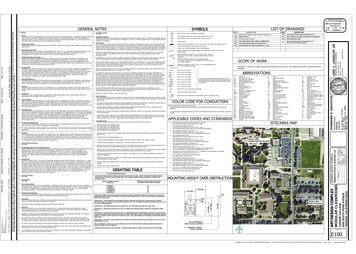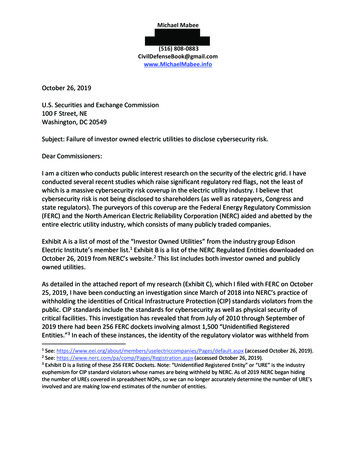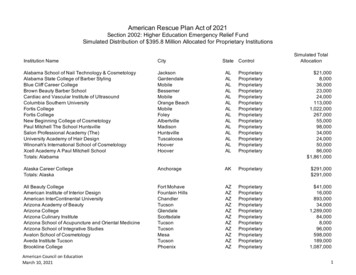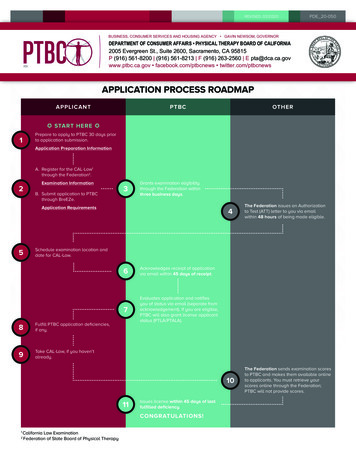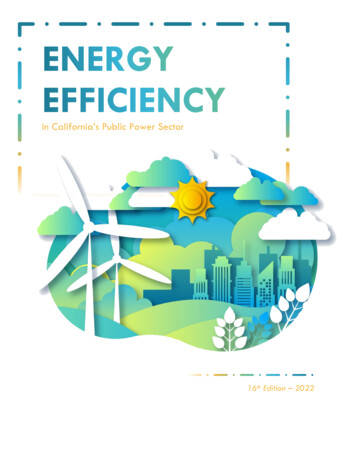
Transcription
in California’s Public Power Sector16th Edition – 2022
TABLE OF CONTENTSAcknowledgements . 1Executive Summary . 1Introduction . 4Program Results . 5Policy Considerations . 5Resources and Tools. 20Sources of Funding . 23Appendix A – POU Narratives .A-24Appendix B – Calculation Reference .B-1EE in California’s Public Power Sector: 16th Edition — 2022
ACKNOWLEDGEMENTSThis report would not be possible without the substantial contributions of the following individuals:Project Managers: Bryan Cope and Joanna Ruiz, Southern California Public Power Authority (SCPPA)Frank Harris, California Municipal Utilities Association (CMUA)Emily Lemei, Northern California Power Agency (NCPA)Heather HeinbaughAlameda Municipal PowerShant Boodanian, Andrew Kanzlerand Brian ZimmermanAnaheim Public UtilitiesPaul Reid and Liza SagunAzusa Light & WaterAmber Rockwell and Jim SteffensCity of BanningMarlee MattosCity of BiggsRuzan Soloyan and Drew KiddBurbank Water & PowerJessica Sutorus and Adrianne RogersCity of ColtonHerbert GarciaGlendale Water & PowerHugo Valdez and Sabrina BarberImperial Irrigation DistrictTheresa PhillipsLassen Municipal Utility DistrictAstrida TrupovnieksCity of LodiSteven ValleCity of LompocArmen Saiyan, Damon Turney, Jeremiah Valera,and Luke SunLos Angeles Department of Water & PowerVanessa LaraMerced Irrigation DistrictPeter Govea and Bob HondevilleModesto Irrigation DistrictMichael McLellanCity of Moreno ValleyRainie TorranceCity of NeedlesMicah Babbitt and Lisa BenatarCity of Palo Alto UtilitiesJonathan SunPasadena Water & PowerVanessa XieCity of PittsburgEmily ComptonPlumas-Sierra Rural Electric CooperativeJared CarpenterPort of OaklandTrina ValdezCity of Rancho CucamongaKamryn HutsonRedding Electric UtilityJessica Nguyen, Griselda Rivera and Sandra MejiaRiverside Public UtilitiesRachel Radell-Harris and David BradfordRoseville ElectricJillian Rich and Richard ObergSacramento Municipal Utility DistrictDaniel Young and James HendrySan Francisco Public Utilities CommissionJames TakeharaCity of Shasta LakeMary Medeiros McEnroeSilicon Valley PowerSarah SheetzTrinity Public Utility DistrictSteve KeatesTruckee Donner Public Utilities DistrictAldo Lara and Monique HamptonTurlock Irrigation DistrictAnthony SerranoCity of Vernon Public UtilitiesLen ViejoASTRUM Utility ServicesMiranda Boutelle, Mark Gosvener and Nadya KleinEfficiency Services GroupEE in California’s Public Power Sector: 16th Edition — 20221
E XECUTIVE S UMMARYCalifornia’s Publicly Owned Utilities (POUs) continue to collaborate to develop cost-effectiveEnergy Efficiency (EE) programs and report annual results to their customers and the CaliforniaEnergy Commission (Energy Commission) in a consistent and comprehensive manner. This 16thedition report presents the latest results from POUs’ wide range of EE programs.During the Fiscal Year (FY) 2021 reporting cycle, POUs expended 159 million on EE programsfor their communities, including low-income customers, resulting in 254 Gigawatt hours (GWh) ofnet annual energy savings and reducing peak demand by 82 Megawatts (MW). Since theenactment of Senate Bill (SB) 1037 (Kehoe, 2005), public power has spent nearly 2.5 billion onEE and demand reduction, achieving over 97,235 GWh in net lifecycle energy savings.2021POUs expended 159 million onenergy efficiency programsSince 2006, nearly 2 .5 billion invested inEnergy efficiencyResulting in over254 GWh ofannual energy savings*Achieving over2,857GWh in netlifecycle energy savings*This includes EE and LI. It does not include C&S.EE in California’s Public Power Sector: 16th Edition — 20222
Comparing these numbers with those of previous years shows the clear impact that theCoronavirus (COVID-19) pandemic continues to have on EE performance and California’s energyeconomy in general. California’s electricity demand continued to be down in 2021, keeping EEprogram yields below pre-pandemic levels. Additionally, in order to protect the health of ourcustomers, staff, and the general public, some programs had to be suspended. For example,programs requiring direct interaction, such as Direct Install, had to be suspended due to state andlocal health restrictions. As indicated in the utility narratives, some of California’s POUs began toreturn to programs that require direct interaction while other POUs have indicated that theyintend to return to these programs in 2022. Moving forward, it will be useful to observe what newmethods of program administration have been developed during the pandemic. Work styles arechanging following the pandemic, California’s POUs are evaluating new methods to costeffectively reduce both energy use and Greenhouse Gas (GHG) emissions. The successes of thepast provide an excellent foundation on which public power will continue to build.Appendix A contains additional information on each POU’s portfolio including programdescriptions, expenditures, and energy savings. Appendix B presents a comprehensive outline ofthe calculations used within the Cost Effectiveness Tool (CET) Reporting Platform (RP) (CET/RP).EE in California’s Public Power Sector: 16th Edition — 20223
I NTRODUCTIONPursuant to the Public Utilities Code, each year POUs are required to report the followinginformation to customers and the Energy Commission : 11. Investments in EE and demand reduction programs.2. Descriptions of each EE and demand reduction program, program expenditures, costeffectiveness of each program, and expected and actual EE savings and demandreduction results.3. Sources for funding of EE and demand reduction programs.4. Methodologies and input assumptions used to determine cost-effectiveness of programs.5. A comparison of the POUs’ annual EE targets and the POUs’ reported electricity efficiencysavings and demand reductions.This collaborative report compiles the required data from the individual POUs into a single,comprehensive document in compliance with the California Public Utilities’ Code.The State’s POUs supply approximately one-quarter of California’s electricity to a broad rangeof communities with widely differing climates, customer bases, and economic conditions. Thiscompilation is presented to foster analyses of broader EE trends and offer policymakers datadriven considerations regarding the practical impacts of related policies.The POUs have long supported California’s EE policies and administered programs to providefinancial incentives and rebates to POU customers for investments in a variety of energy savingmeasures. The purpose of this report is to look back on the success of the past year, in addition tolooking ahead to inform discussions on how best to achieve additional energy savings in thefuture.“ F i r st p l a c e g oe s t o C a l if o r n ia , w h ic h se t s t h ep a c e i n sa v ing e ne r g y o n m u l t ip l e f r o nt s w it ha d o p t io n o f ne t - z e r o e n e r g y b u il d i ng c o d e s ,s t r i ng e nt v e h ic l e e m i s s io n s st a nd a r d s , a ndi n d u st r y - l e a d ing a p p l ia nc e st a nd a r d s .”A C E E E 2 0 2 0 S t a t e E E S c o re c a r d1California Public Utilities Code (Cal. Pub. Util. Code) § 9505EE in California’s Public Power Sector: 16th Edition — 20224
P ROGRAM R ESULTSThis section provides an overview of the EE program results for public power in California duringFY 2021. Most POUs manage and implement EE programs on a fiscal year basis; for POUs thatoperate on a calendar year basis, their respective report results for FY 2021 are equal to that ofCalendar Year 2021. 2In summary, during the 2021 reporting cycle, POUs collectively spent 159 million on EEprograms, resulting in 254 GWh of net annual energy savings, with 2,851 GWh of net lifecycleenergy savings and reduced peak demand by 82 MW.TABLE 1: Historic Program ResultsFiscal YearNet PeakSavings(kW)Net AnnualSavings (MWh)Net LifecycleSavings(MWh)Total 5,221,7872,850,85397,234,831 54,412,728 63,151,647 103,907,266 146,093,107 123,433,250 132,372,795 126,936,631 134,475,230 169,940,735 162,896,993 154,796,668 226,386,251 218,730,235 260,675,319 261,918,171 158,527,378 2,498,654,404As shown in Table 1, public power has collectively spent 2.5 billion on EE programs, resulting in97,235 GWh in net lifecycle energy savings since 2006 and avoided the development of 1,598MW of generation resources to serve peak demand during that time. Table 1 also shows that NetAnnual Savings continue to be below that realized before the beginning of the pandemic,providing further evidence of the impact COVID-19 has had on the State’s energy economy.2POU fiscal years run from July 1 to June 30, except for the following POUs who operate on a calendar yearbasis: Imperial Irrigation District, Merced Irrigation District, Modesto Irrigation District, Plumas-Sierra Rural ElectricCo-op, Sacramento Municipal Utility District, Truckee Donner Public Utility District, and Turlock Irrigation District.EE in California’s Public Power Sector: 16th Edition — 20225
California’s POUs continue to support the statewide goal of doubling EE by 2030 under theEnergy Commission’s direction. Using the Energy Commission’s methodology to determinecumulative energy savings, POUs’ cumulative first year savings from FY 2015 through FY 2021equals 4,293 GWh, as presented in Table 2 below. In spite of the effects of the pandemic, thesecumulative savings remain 224 GWh above the target cumulative goals for California POUs. 3 ThePolicy Consideration section discusses in further detail the importance of POUs’ efforts to helpmeet the State’s doubling of EE goals.TABLE 2. California POU Cumulative 1st Year Energy Savings ComparisonNet 1st Year Savings (GWh) per Installation 44.7771.6861.9638.7646.3475.6254.34,293.1CEC CumulativeSavings Target4,069.0The Energy Commission methodology used to calculate “cumulative” savings shown in Table 2combines only the “first year savings” from each of the POUs’ portfolios in the respectivereporting years to calculate “cumulative savings”. POUs are concerned that this calculation doesnot account for any expected useful life of the efficiency measures in the portfolios or savingspersistence from behavioral changes after an efficiency improvement has been made.Therefore, in addition to the representation of POUs’ cumulative savings in Table 2, POUs havealso calculated alternative representations of the cumulative energy savings from their combinedportfolios that potentially better reflect the true cumulative impact of EE savings on the electricgrid. This has been done to begin an important discussion on POUs’ and the Energy Commission’sability to assess and value energy savings from EE programs on an equivalent basis.Table 3, shown below, represents the cumulative savings as the Lifecycle Savings from all the EEmeasures installed each year in the POUs’ EE portfolios.TABLE 3. California POU Cumulative Lifecycle Savings ComparisonCumulative Savings (GWh) Per Installation Year201520167,836.6 1.68,267.57,312.35,221.82,850.953,734.3Table 3 accurately accounts for the savings achieved by all measures over their expected usefullife. However, at this time there is no degradation factor included in the modeling to reflectpotential loss of use, nor is there any measure or estimation of customers’ behavioral changes togauge a level of persistence in use of efficient measures – rather than revert to less efficientequipment upon burnout or end of the efficient measure’s life. Regardless, Lifecycle Savings, as3Energy Commission, October 2017, Senate Bill 350: Doubling EE Savings by 2030, Table A-11.EE in California’s Public Power Sector: 16th Edition — 20226
calculated today, may be a better representation of cumulative savings than 1st year AnnualSavings.Table 4 shows the cumulative energy savings from all of the measures that are in effect or activein each of the years depicted, including current and historical measures. Whereby, when ameasure’s life ends, the savings for that measure are no longer counted. There is strong potentialthat this representation is the closest to the definition of cumulative savings. However, the primarydrawback to this method when considering a single point forecast, such as “cumulative savings in2030”, is that a utility receives no “credit” for any energy savings achieved from measuresinstalled between 2015 and 2029 whose expected useful life has expired. That is, a measure, nomatter when installed, would have to be active in 2030 to count towards the cumulative doublingof efficiency savings goal.TABLE 4. California POU Cumulative Active Measure Energy Savings ComparisonNet Cumulative Savings (GWh) Per Installation ,574.3Table 5 below provides a comprehensive summary of the EE savings for all POUs’ respective EEPortfolios in FY 2021. The 16 largest utilities subject to Integrated Resource Plan (IRP)requirements account for the majority of savings within the public power community. As in pastyears, the two largest POUs, Los Angeles Department of Water & Power (LADWP) andSacramento Municipal Utility District (SMUD), accounted for roughly two-thirds of the total POUsavings during the 2021 reporting cycle. Taken as a group, the 16 IRP POUs produced 97% ofthe total savings. The remainder of the savings were realized by 32 smaller and mid-sized POUslocated throughout California.EE in California’s Public Power Sector: 16th Edition — 20227
TABLE 5. EE Program Results by CLassenLodiLompocLos AngelesMercedModestoMoreno ValleyNeedlesPalo AltoPasadenaPittsburgPlumas-SierraPort of OaklandRancho CucamongaReddingRiversideRosevilleSacramentoSan FranciscoShasta LakeSilicon Valley PowerTrinityTruckee DonnerTurlockUkiahVernonVictorvilleEE and Low IncomeSubtotalGross PeakSavings (kW)Gross AnnualSavings (kWh)Gross LifecycleNet PeakEnergy SavingsSavings 038,998-87,872275,779,000-Net AnnualEnergy 32Net LifecycleNet LifecycleEnergy Savings GHG ,57812,356,0554,695Total UtilityCostUtility( /kWh)PACTRC 1,023,586 2,506,333 1,326,261 160,431 12,782 2,032,144 351,558 0 1,373,543 45,606 196,287 2,876,532 0 124,093 443,192 178,759 93,784,254 286,134 2,943,644 12,932 1,425,857 0633,03448414,798 104,628 12,984 74,933 3,273,319 2,951,320 5,536,239 24,930,574 833,807 152,637 6430412,955- 258,070 1,232,039 68,245 425,415 4489,998 158,527,3781.511.430.075EE in California’s Public Power Sector: 16th Edition — 2022-8
Table 6 breaks down the statewide results by end-use. As has occurred for the past few years, lighting programs once again accountfor the largest share (37%) of the gross annual EE program savings.TABLE 6. EE Program Results by End-Use CategoryEnd-UseAllAppliance & Plug LoadsBROsBuilding EnvelopeCodes & StandardsCommercial RefrigerationFood ServiceHVAC - CoolingHVAC - Heat PumpHVAC - HeatingLighting - IndoorLighting - OutdoorMiscellaneousProcessService & Domestic Hot WaterTransmission & DistributionWater Pumping / IrrigationWhole BuildingEE SubtotalLow IncomeGross PeakSavings (kW)Gross AnnualSavings (kWh)Gross LifecycleNet PeakEnergy SavingsSavings 56,7647,785299,500,847Net AnnualEnergy 2Net LifecycleNet LifecycleEnergy Savings GHG 8615,72113,499,71835,415289,355,284Total UtilityCostPACTRCUtility( /kWh)4,305,215 5,498,967996,565 ,6248,374 1,152,312793,718 20,073,893512,545 91,66334,297,205 15,730,4553,235,601 4,520,857234,970 406,865936,077 9,784,247 138,940,211 670.337EE and Low Income 0,3332,850,853,984489,998 158,527,3781.511.430.075Codes and StandardsElectrificationTransmission and DistributionC&S T&D and 7,621243,075,8915,743,511163,48010,6522,740 15,356,422 11,143,210 ,867,023176,872 ,028127,806545,847,3826,889,721,007666,870 185,389,8672.202.130.037Utility TotalEE in California’s Public Power Sector: 16th Edition — 20229
Table 7 presents the statewide EE program results by sector. As has historically been the case, the C&I sectors account for the majorityof California POUs’ annual energy savings (72%), while residential programs resulted in 27% of the gross annual EE program savings.TABLE 7. EE Program Results by esidentialEE SubtotalLow IncomeEE and Low Income SubtotalCodes and StandardsElectrificationTransmission and DistributionC&S T&D and ElectrificationSubtotalUtility TotalGross PeakSavings (kW)Gross AnnualSavings (kWh)Gross LifecycleNet PeakEnergy SavingsSavings 9676,855,7832,6993,094,107,37381,596Net AnnualEnergy 59,424,132246,588,2347,722,099254,310,333Net LifecycleNet LifecycleEnergy Savings GHG 3,984489,998Total UtilityCostPACTRCUtility( /kWh) 298,654 78,285,030 1,529,319 309,792 58,517,416 138,940,211 19,587,167 40 15,356,422 11,143,210 ,867,023176,872 ,028127,806545,847,3826,889,721,007666,870 185,389,8672.202.130.037Table 8, on the next page, presents the statewide EE program results by building type.EE in California’s Public Power Sector: 16th Edition — 202210
TABLE 8. EE Program Results by Building TypeSummary by Building TypeBuilding TypeAllAssemblyEducation - Community CollegeEducation - Primary SchoolEducation - Relocatable ClassroomEducation - Secondary SchoolEducation - UniversityGroceryHealth/Medical - HospitalHealth/Medical - Nursing HomeLodging - HotelLodging - MotelManufacturing BiotechManufacturing Light IndustrialOffice - LargeOffice - SmallOther AgriculturalOther CommercialOther IndustrialResidentialResidential - Multi-FamilyResidential - Single-FamilyRestaurant - Fast-FoodRestaurant - Sit-DownRetail - Big BoxRetail - LargeRetail - SmallStorage - ConditionedStorage - UnconditionedWarehouse - RefrigeratedEE SubtotalLow IncomeEE and Low Income SubtotalCodes and StandardsElectrificationTransmission and DistributionC&S T&D and Electrification SubtotalUtility TotalResource Savings SummaryGross PeakSavings (kW)Gross AnnualSavings 49134,087567,356,649Gross LifecycleNet PeakEnergy SavingsSavings E in California’s Public Power Sector: 16th Edition — 637,4158,7682746,210127,806Net AnnualEnergy 28,6024,383,612291,537,049545,847,382Cost Test ResultsNet LifecycleNet LifecycleEnergy Savings GHG 6522,740176,872666,870Total UtilityCostPACTRCUtility( /kWh) 16,691,758 5,695,465 225,546 300.0360.154 4,515,781 3,700,030 3,629,616 2,709,315 207,882 605,171 1,658 36,302 1,671,495 9,126,357 462,675 1,322,453 14,095,352 2,363,693 12,032,032 2,742,494 43,737,991 19,971 34,808 171,869 1,143,243 290,003 252,083 50,849 961,781 138,940,211 19,587,167 158,527,378 15,356,422 11,143,210 362,857 3370.0750.0060.0600.0660.009 185,389,8672.202.130.03711
Table 9 compares the actual savings in 2021 to the POUs’ adopted annual targets for eachutility. In total, the actual energy savings were approximately 73% below forecasted levels for2021.TABLE 9. Forecast vs Actual for Installation Year mpocLos AngelesMercedModestoMoreno ValleyNeedlesPalo AltoPasadenaPlumas-SierraPort of OaklandRancho CucamongaReddingRiversideRosevilleSacramentoSan FranciscoShasta LakeSilicon Valley PowerTrinityTruckee ossNetNetNetNetGrossNetNetNetNetEE Forecast(MWh)EE Actual 4,928252,69421,3571,84412,797685974,6894 5EE 332427To be consistent with EE savings reported in Table 3, Annual targets exclude codes and standards savings.Not all Small, Non-IRP POUs are included in this list because they either did not exist when the 2017 forecastswere developed, did not develop forecasts in 2017, or did not have any energy savings in 2021.EE in California’s Public Power Sector: 16th Edition — 202212
P OLICY C ONSIDERATIONSThis section provides an overview of the policy considerations surrounding the development,implementation, and successes of public power’s EE programs.California is a leader in advancing EE policies and technologies, and the State’s work in this areahas had a well-documented dramatic impact on electricity demand. Since the establishment of theTitle 24 building standards in 1978, EE programs have saved California consumers in excess of 100 billion. 6 POU communities have played a key role in supporting the State’s accomplishmentsand look forward to a continuing partnership with all stakeholders, as the state pursues its cleanenergy agenda.The Pandemic and Electricity DemandCOVID-19 resulted in the shutdown of whole segments of California’s economy and causedCalifornians to spend much of 2021 working at home. In 2021 the pandemic continued to have anunprecedented impact on California’s electricity demand and the State’s economy as a whole.Comparing the data in this Draft Report with those of previous years demonstrates the clearimpact the pandemic has had on EE performance.Similar to 2020, in 2021 residential demand increased, particularly in the summer months, whileCommercial and Industrial (C&I) demand has decreased by even more. 7 On balance, electricitydemand in California looks to be approximately 4.5% lower on a year-to-date level. As a resultof these changes in ele
Since inception of the EE programs, Azusa Light & Water (ALW) has expended over 15 million toward providing energy conservation information to the Azusa community and rewarding businesses and residents for upgrading inefficient energy consuming equipment with more EE equipment. These efforts have resulted in an annual peak demand and energy .

